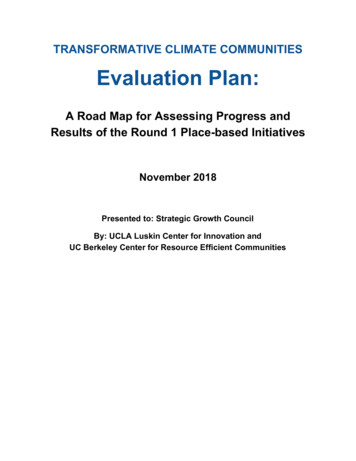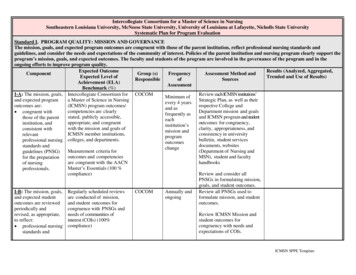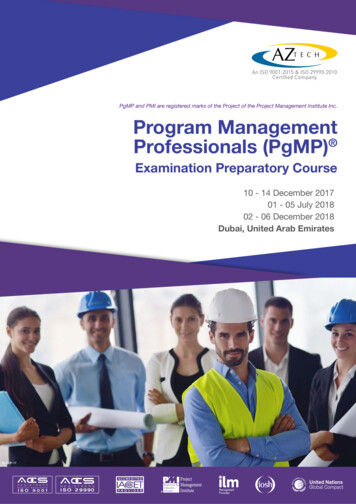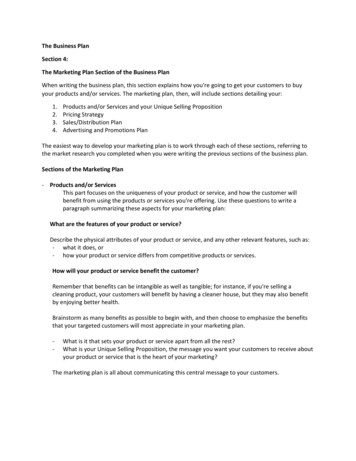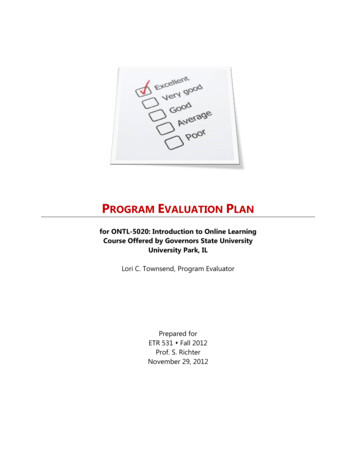
Transcription
PROGRAM EVALUATION PLANfor ONTL-5020: Introduction to Online LearningCourse Offered by Governors State UniversityUniversity Park, ILLori C. Townsend, Program EvaluatorPrepared forETR 531 Fall 2012Prof. S. RichterNovember 29, 2012
EXECUTIVE SUMMARYThere has been ample research and literature which suggests that dropout rates for onlinecourses tend to be significantly higher than the dropout rates for traditional face-to-facecourses. The reasons for these results often include one or more of the following:A. many learners taking their first online course lack sufficient computer skills;B. many learners are relative newcomers to the Internet;C. many first-time online learners have minimal or no previous experience with integratingtechnology with human interaction in order to communicate effectively;D. many learners who enroll in an online course do so without having any way to assesswhether this learning environment is appropriate for their learning style.This evaluation has been designed to determine the effectiveness of the Introduction to OnlineLearning course at Governors State University for preparing learners for success in the 21stCentury online classroom. The evaluation seeks to address questions from a number ofstakeholders, including students, instructors, and administrators at the university.Page 2Table of Contents
TABLE OF CONTENTSClick the blue hyperlinks below to view each section of this report.I. Executive SummaryII. Introduction to the Evaluation ReportA. Program DescriptionB. Evaluation NeedsIII. Evaluation Purpose & FocusA. Program Logic ModelB. Stakeholder IdentificationIV. Evaluation DesignA. Evaluation MeasuresB. Evaluation Management Plani.Evaluation Timelineii.Evaluation BudgetV. Findings and RecommendationsVI. ReferencesVII. AppendicesA. Samples of Evaluation MeasuresA1. Student Evaluation of Instruction (SEI) SurveyA2. Instructor Interview QuestionsA3. Student Focus Group QuestionsA4. Student Focus Group QuestionsA5. Quality Matters RubricA6. Scoring Sheet (for use with Quality Matters Rubric)B. Evaluator ResumeC. Human Subjects Protection Training CertificatePage 3Table of Contents
PROGRAM DESCRIPTIONProgram BackgroundIntroduction to Online Learning is a comprehensive orientation to online learning that allowslearners to address any knowledge gaps that exist in their preparation for successful onlinelearning. Open to undergraduate and graduate students at Governors State University (GSU),this course provides an immersive online learning experience which introduces learners to thetechnologies, communication tools, and learning processes that are employed in the onlineclassroom. Learners will: (a) analyze differences between online and traditional learning; (b)identify their own, individual learning styles and determine what adaptations, if any, may berequired to succeed in an online course; (c) review the characteristics of successful onlinelearners; (d) learn to utilize the vast resources of the Internet to facilitate learning; and (e) assesstheir own potential as an online learner in relationship to these issues.Program Location and SizeIntroduction to Online Learning is a fully-online course, with 100% of course activities occurringsynchronously and asynchronously via the Internet. GSU uses the Blackboard 9.1 LearningManagement System to support and facilitate its online courses. This 2 credit hour course is offeredtwice during each semester of the academic year, with enrollment in each section of the course limitedto a total of 25 students.Program OrganizationIntroduction to Online Learning is offered by the Center for Online Teaching and Learning(COTL), which supports all courses at GSU, and provides faculty development services under thedirection of the Dean of the College of Education. For purposes of this evaluation, the instructorof record for this course will direct this course evaluation.Page 4Table of Contents
Special Political ConsiderationsPrior to the Fall 2012 semester, COTL was a unit within the Digital Learning and Media Designdepartment. During a recent institutional restructuring initiative, COTL was reassigned to theCollege of Education to provide primary support to its new online programs and faculty.Evaluation NeedsBecause this course is now under the purview of the College of Education, the college Dean hasrequested that all instructors teaching online courses in the fall semester provide a writtenevaluation of their online courses at the end of the semester. The Dean of the College ofEducation encourages continuous program evaluation and improvement, with an emphasis onidentifying the strengths and weaknesses of online course offerings in the College. To this end,the focus of this evaluation will be summative, and will be conducted during the fall 2012semester, with the final report presented to the Dean at the end of the term.Page 5Table of Contents
PROGRAM GOALS AND OUTCOMESProgram Logic utcomesImpactsIntended Work Skills of instructionaldesign staff Experienced onlineinstructors Approved syllabus Student evaluations Clerical support Faculty developmenttraining/OnlineTeaching certificate Computer access forfaculty, staff andstudents Technical support Offices/ furniture Blackboard LMS Software Internet access Support of ProvostIntended Result Use LMS and othertools to completecourse requirements Use synchronous andasynchronouscommunication tocollaborate withother learners Retrieve and criticallyevaluate informationon the Internet Assess onlinelearning skills Instructor and CourseEvaluationPage 6 Active and engagedlearner participationin class discussionforums Multimediapresentation ofgroup assignment Annotatedbibliography project Reflection paperdiscussing the onlinelearning experience Completed StudentEvaluation ofInstruction (SEI) form Increased enrollmentin online courses Increased successrate of onlinelearners Improved quality ofonline teaching andlearning at GSUTable of Contents Better preparedonline learners Improvedcompetence of onlineinstructors
Stakeholder ChecklistIndividuals, groups, oragencies needing theevaluation findingsTomakepolicyTo makeTo provideForoperational input toTo react interestdecisions evaluationonly Provost’s OfficeCollege Dean Department Head Students who took the courseCourse instructor Instructional design teamUniversity faculty College curriculum committee University accrediting officeStakeholder Priority1. Stakeholders with decision authorityThe findings of this evaluation will aid the Provost and College Dean in making appropriatepolicy decisions that support the university’s mission and strategic plan.2. Stakeholders with direct responsibilityDepartment Heads and instructional designers may utilize the evaluation findings to assist themin making operational changes to improve curriculum development.3. Intended BeneficiariesThe primary beneficiaries of this evaluation will be the students who take enroll in theIntroduction to Online Learning course and the instructors who teach it.4. Disadvantaged StakeholdersIn response to student demand for more online courses, GSU has seen a dramatic increase inenrollment in its online courses and programs. This sustained popularity of online learning mayeventually lead to a corresponding decrease in demand for traditional face-to-face courses oncampus. Instructors and students who prefer traditional classroom teaching and learning maybecome disadvantaged as a result of reduced on-campus course offerings.Page 7Table of Contents
Evaluation DesignThe following Evaluation Purpose Statement describes the focus and anticipated outcomes of the evaluation:The purpose of this evaluation is to demonstrate the effectiveness of this online course in preparing adult learners for success in the 21stCentury online classroom. The results of the evaluation will be used to enhance the design and content of the course to ensurecontinued relevance for learners.Evaluation QuestionsOutcomes (Summative)Relationships �s Office Who are our online students? Annual reports, speeches, marketingCollege Dean How much does this course cost? Curriculum funding and resource allocationDepartment HeadUniversity accrediting officeUniversity faculty College curriculum committee Which courses are/should be approved for online delivery?Students who took the courseCourse instructorInstructional design teamHow many students register for online courses each term?How many instructors teach online courses each term?What percentage of students successfully completes this course each term?What is the student/instructor ratio for this course?How accessible is the instructor for this course?What percentage of students successfully completes this course each term?What do online learners need to know to be successful in this course?Which student groups are taking online courses?Which instructors are teaching online courses?Does the course meet accreditation standards?Will students completing this course be prepared for online learning?stProvost’s Office Are we adequately preparing our students for 21 Century learning?College Dean How effective are our online courses?Department Head Are instructors effective in the online classroom? Are students achieving learning outcomes? Is online learning appropriate for me?Students who took the courseCourse instructorAre my online teaching strategies effective?Are my students learning?Does the course employ universal design concepts?Are course materials presented for various learning styles?Does the course meet accreditation standards? Teaching assignments/course loads Recruitment Course selection Teaching improvement Course review/improvement Program review Technology integration considerations Program review Annual reports, speeches, marketingCurriculum funding requestsProgram improvementProgram reviewIdentify training/support needs Future course selection Teaching improvementUniversity accrediting office University faculty Will students completing this course be prepared for online learning? Technology integration considerationsCollege curriculum committee Are instructors effective in the online classroom? Are students achieving learning outcomes? Program improvement Program reviewInstructional design teamPage 8Table of Contents Course review/improvement Program review
Consolidated Evaluation QuestionsEvaluation QuestionRationale1. How are students/instructors reacting tothe course?Addresses questions from students andinstructors2. How has this course impacted studentlearning outcomes?Addresses questions from all stakeholdergroups3. How effective is this course in preparingstudents for 21st Century learning?Addresses questions from all stakeholdergroupsEvaluation Plan MatricesEvaluation Question #1 How are students/instructors reacting to thecourse?Information RequiredCourse evaluationInformation SourceStudents who have taken the course and instructors whohave taught the courseMethodStudent Evaluation of Instruction (SEI) survey; Instructorinterviews; student focus groupsSamplingSEIs for all registered student; Student focus groups(voluntary participation) at the end of the term; Instructorinterviews with all instructors teaching online coursesInformation CollectionProceduresSEIs will be administered to all registered students during thefinal week of the course. Student focus groups will befacilitated by the Dean of the College of Education duringseveral “Online Chat with the Dean” sessions. Instructorinterviews will be conducted in small groups by DepartmentHeads during 1-hour weekly departmental meetings.ScheduleSEIs administered during final class meeting (before finalgrades are posted); student focus groups facilitated aftercourse ends; Instructor interviews conducted after finalsemester grades are postedAnalysis ProceduresSEI data will be tabulated using a standard statistical softwareapplication. Written student comments on SEIs, and notesfrom student focus groups and instructor interviews will betranscribed and analyzed to identify patterns related tocourse reactions. All resulting data will compared withcourse objectives and standards.Page 9Table of Contents
Evaluation Question #2 How has this course impacted studentlearning outcomes?Information RequiredStudent feedbackInformation SourceStudents who have taken the courseMethodStudent focus groupsSamplingStudent focus groups (voluntary participation) at the end ofthe termInformation CollectionProceduresStudent focus groups will be facilitated by the Dean of theCollege of Education during several online “Chat with theDean” sessions.ScheduleStudent focus groups will be conducted after the course endsAnalysis ProceduresNotes from student focus groups will be transcribed andanalyzed to identify patterns related to learning outcomes.All resulting data will compared with course objectives andstandards.Evaluation Question #3 How effective is this course in preparingstudents for 21st Century learning?Information RequiredCourse evaluationInformation SourceInstructional designersMethodThe course will be evaluated using the Quality Matters Rubricpresented athttp://www.qmprogram.org/files/QM Standards 20112013.pdfSamplingThe course will be evaluated against the Quality MattersRubricInformation CollectionProceduresThe instructional designers will use a Scoring Sheet toevaluate the course syllabus, course website, instructionalactivities, accessibility, and assessment strategies against the8 standards identified in the Quality Matters Rubric. Therubric includes a rating scale that will be used to provide anoverall rating of the course.ScheduleThe Quality Matters Rubric evaluation will be conductedduring the fall 2012 semester.Analysis ProceduresResults of the rubric analysis will be analyzed to identifypatterns and areas for improvement. The rubric results willbe included in the final evaluation report.Page 10Table of Contents
LIST OF EVALUATION MEASURES*Evaluation Measures for Evaluation Question #1Student Evaluation of Instruction (SEI) SurveyAppendix A1Instructor Interview QuestionsAppendix A2Student Focus Group QuestionsAppendix A3Evaluation Measures for Evaluation Question #2Student Focus Group QuestionsAppendix A4Evaluation Measures for Evaluation Question #3Quality Matters RubricAppendix A5Scoring SheetAppendix A6*The complete Measures/Instruments are provided in the Appendix.Page 11Table of Contents
EVALUATION MANAGEMENT PLANProposed Evaluation TimelinePROJECT GANTT CHARTActivityResourcesDevelop evaluationmeasuresEvaluatorConduct surveyInstitutional surveyofficeRecruit subjectsEvaluatorConduct focusgroupsConduct interviewsTIMELINE (in weeks)123456Evaluator,students, collegeDeanEvaluator,instructors,department headsConduct rubricevaluationInstructionaldesignersAnalyze dataEvaluator,graduate assistantPrepare final reportEvaluatorPresent reportfindingsEvaluatorDeliver final reportEvaluatorPage 12Table of Contents
Estimated Evaluation BudgetPersonnel CostsEvaluator, 1.5 months @ 4100/mo. 6150.00Graduate assistant, 60 hours @ 12.50/hr. 750.00College Dean, 1 hour (for online student focus group)In-Kind*Department head, 1 hour (for instructor interviews)In-Kind*2 instructors, 1 hour (for interviews with department head)In-Kind*Total Personnel Costs 6900.00Direct CostsParticipant support costs (focus groups, interviews) 250.00Materials and Supplies 250.00Software (statistical, transcription, productivity)In-Kind*Office, utilities, computer, printer, internet, phone, email accountIn-Kind*Printing/Duplication 100.00Total Direct Costs 600.00Total Project Costs 7500.00* Note: In-Kind Costs have been provided by the Institution.To support this evaluation effort, the college Dean will provide office space, computerequipment, standard statistical and productivity software, and a graduate student assistantto provide data collection and support assistance.Page 13Table of Contents
REFERENCESFitzpatrick, J. L., Sanders, J. R., & Worthen, B. R. (2011). Program evaluation: Alternativeapproaches and practical guidelines. Boston: Pearson (Allyn and Bacon).Morrison, G. R., Ross, S. M., & Kemp, J. E. (2007). Using evaluation to enhance programs:Conducting formative and summative evaluations. In Designing EffectiveInstruction (5th edition). Hoboken, NJ: John Wiley & Sons.Quality Matters Rubric Standards 2011-2013 Edition with Assigned Point Values.Retrieved from http://www.qmprogram.org/files/QM Standards 2011-2013.pdfStudent Evaluation of Instruction (SEI) Survey. Governors State University, UniversityPark, IL. Sample reprinted with permission of instructor Lori Townsend.Thompson, N. J. & McClintock, H. O. (1998). Demonstrating your program’s worth: Aprimer on evaluation for programs to prevent unintentional injury. Atlanta:Centers for Disease Control and Prevention, National Center for Injury Preventionand Control.W. K. Kellogg Foundation (2001). Logic Model Development Guide. Retrieved fromwww.wkkf.org/ .pdfPage 14Table of Contents
APPENDICESA.Evaluation MeasuresA1. STUDENT EVALUATION OF INSTRUCTION (SEI) SURVEYPage 15Table of Contents
STUDENT EVALUATION OF INSTRUCTION (SEI) SURVEY (cont.)Page 16Table of Contents
A2. INSTRUCTOR INTERVIEW QUESTIONSEvaluation Question: How are students/instructors reacting to the course? In what ways do you feel this course is useful to students? How often do you update course content? What content is typically updated? What, if any, changes do you plan to make the next time you teach this course? What specific assistance/information would be helpful to you in implementingnew practices or integrating new technologies in this course?A3. STUDENT FOCUS GROUP QUESTIONSEvaluation Question: How are students/instructors reacting to the course? What was the most significant result/impact of your participation in this course? What immediate steps/actions will you take as a result of this course? What specific assistance/information would have been helpful to you BEFORE youbegan taking this course?A4. STUDENT FOCUS GROUP QUESTIONSEvaluation Question: How has this course impacted student learning outcomes? What new skills did you learn in this course that you can use in the future? How will you apply the skills you learned in this course? What new practice(s) will you implement as a result of taking this course?Page 17Table of Contents
A5. Quality Matters Rubric (retrieved from http://www.qmprogram.org/files/QM Standards 2011-2013.pdf)Page 18Table of Contents
A6. Scoring Sheet for use with Quality Matters RubricStandardsPoints1. Course Overview and Introduction (possible points 14)1.1 Instructions make clear how to get started and where to find various course components. [if yes, add 3points]1.2 Students are introduced to the purpose and structure of the course. [if yes, add 3 points]1.3 Etiquette expectations (sometimes called “netiquette”) for online discussions, email, and other forms ofcommunication are stated clearly. [if yes, add 2 points]1.4 Course and/or institutional policies with which the student is expected to comply are clearly stated, or alink to current policies is provided. [if yes, add 2 points]1.5 Prerequisite knowledge in the discipline and/or any required competencies are clearly stated. [if yes, add1 point]1.6 Minimum technical skills expected of the student are clearly stated. [if yes, add 1 point]1.7 The self-introduction by the instructor is appropriate and available online. [if yes, add 1 point]1.8 Students are asked to introduce themselves to the class. [if yes, add 1 point]2. Learning Objectives (possible points 15)2.1 The course learning objectives describe outcomes that are measurable. [if yes, add 3 points]2.2 The module/unit learning objectives describe outcomes that are measurable and consistent with thecourse-level objectives. [if yes, add 3 points]2.3 All learning objectives are stated clearly and written from the students’ perspective. [if yes, add 3 points]2.4 Instructions to students on how to meet the learning objectives are adequate and stated clearly. [if yes,add 3 points]2.5 The learning objectives are appropriately designed for the level of the course. [if yes, add 3 points]3. Assessment and Measurement (possible points 13)3.1 The types of assessments selected measure the stated learning objectives and are consistent with courseactivities and resources. [if yes, add 3 points]3.2 The course grading policy is stated clearly. [if yes, add 3 points]3.3 Specific and descriptive criteria are provided for the evaluation of students’ work and participation andare tied to the course grading policy. [if yes, add 3 points]3.4 The assessment instruments selected are sequenced, varied, and appropriate to the student work beingassessed. [if yes, add 2 points]3.5 Students have multiple opportunities to measure their own learning progress. [if yes, add 2 points]4. Instructional Materials (possible points 12)4.1 The instructional materials contribute to the achievement of the stated course and module/unit learningobjectives. [if yes, add 3 points]4.2 The purpose of instructional materials and how the materials are to be used for learning activities areclearly explained. [if yes, add 3 points]4.3 All resources and materials used in the course are appropriately cited. [if yes, add 2 points]4.4 The instructional materials are current. [if yes, add 2 points]4.5 The instructional materials present a variety of perspectives on the course content. [if yes, add 1 point]4.6 The distinction between required and optional materials is clearly explained. [if yes, add 1 point]Scoring continues on next pagePage 19Table of Contents
Scoring Sheet for use with Quality Matters Rubric (cont.)StandardsPoints5. Learner Interaction and Engagement (possible points 11)5.1 The learning activities promote the achievement of the stated learning objectives. [if yes, add 3 points]5.2 Learning activities provide opportunities for interaction that support active learning. [if yes, add 3 points]5.3 The instructor’s plan for classroom response time and feedback on assignments is clearly stated. [if yes,add 3 points]5.4 The requirements for student interaction are clearly articulated. [if yes, add 2 points]6. Course Technology (possible points 12)6.1 The tools and media support the course learning objectives. [if yes, add 3 points]6.2 Course tools and media support student engagement and guide the student to become an activelearner. [if yes, add 3 points]6.3 Navigation throughout the online components of the course is logical, consistent, and efficient. [if yes,add 3 points]6.4 Students can readily access the technologies required in the course. [if yes, add 2 points]6.5 The course technologies are current. [if yes, add 1 point]7. Learner Support (possible points 9)7.1 The course instructions articulate or link to a clear description of the technical support offered and howto access it. [if yes, add 3 points]7.2 Course instructions articulate or link to the institution’s accessibility policies and services. [if yes, add 3points]7.3 Course instructions articulate or link to an explanation of how the institution’s academic support servicesand resources can help students succeed in the course and how students can access the services. [if yes,add 2 points]7.4 Course instructions articulate or link to an explanation of how the institution’s student support servicescan help students succeed and how students can access the services. [if yes, add 1 point]8. Accessibility (possible points 9)8.1 The course employs accessible technologies and provides guidance on how to obtain accommodation.[if yes, add 3 points]8.2 The course contains equivalent alternatives to auditory and visual content. [if yes, add 2 points]8.3 The course design facilitates readability and minimizes distractions. [if yes, add 2 points]8.4 The course design accommodates the use of assistive technologies. [if yes, add 2 points]Total Rubric Score (total possible points 95)Add the points in each of the 8 standards sections above to obtain Total Rubric ScorePage 20Table of Contents
B.Evaluator CredentialsLori Crawford TownsendLori.Townsend3@att.netEDUCATIONDoctor of Education, Instructional TechnologyNorthern Illinois University, DeKalb, ILExpected 2016Master of Science in Education, Instructional TechnologyNorthern Illinois University, DeKalb, ILDecember 2012Graduate Certificate, Online TeachingGovernors State University, University Park, ILAwarded December 2010Master of Business AdministrationGovernors State University, University Park, ILAwarded December 1995Bachelor of ArtsChicago State University, Chicago, ILAwarded May 1992EMPLOYMENT HISTORYGovernors State University2008 to presentOffice of the ProvostBusiness/Administrative AssociateProvide high level administrative support to the Provost and Academic Vice President.Duties include fiscal management, meeting and event planning, managing electronicworkflows, maintaining department website, designing and facilitating secure portalworkspaces, conducting research and preparing reports, coordinating committees, andproperty control.Page 21Table of Contents
Governors State University (continued)South Metropolitan Higher Education ConsortiumOperations ManagerProvided high level administrative support for the Consortium, which serves twelve highereducation institutions through various committees and work groups. Duties includedproject management, event planning and logistics management, fund and grantmanagement, automating processes, updating and maintaining website, creating marketingmaterials, conducting research and preparing reports, coordinating committees andmanaging office operations.College of Arts and Sciences, Office of the DeanDistance Learning CoordinatorCoordinated course logistics and support for distance learning faculty and students in theCollege, liaised with campus departments to facilitate student registrations and facultyrequests, scheduled and organized class meetings, orientations & examinations, providedtechnical support for faculty and students using LMS, placed textbook orders, providedtechnical support for video-conferencing activities, prepared course enrollment reports.Adjunct Faculty MemberCourses Taught:A. Interdisciplinary Studies Program IDSS-310: Perspectives on Interdisciplinary Studies (Online & F2F) IDSS-405: Tools for Interdisciplinary Studies (F2F)B. Communication Studies Program COMS-505: Communications Workshop: Effective Time Management (F2F)C. Center for Online Teaching and Learning ONTL-502: Introduction to Online Learning (Online)School of Extended LearningAdministrative Support, College of Arts and SciencesManaged distance learning course entry, liaised with campus departments to facilitatestudent registrations and faculty requests, scheduled and organized class meetings,orientations & examinations, supported faculty and students with questions about theaccessing and using LMS tools, coordinated textbook orders, monitored departmentwebsite, provided technical support for video-conferencing activities, prepared courseenrollment reports.The University of Chicago2000 to 2007Department of PediatricsHuman Resources and Academic Affairs CoordinatorMaintained confidential physician and staff employment records, coordinated medical staffprivileges, managed care credentialing and medical licensure, prepared faculty appointmentcases for recruitment, reappointment and promotion, coordinated departmental compliancePage 22Table of Contents
training for HIPAA, Fraud Awareness, and Patient Safety, organized committee meetings andfaculty development events, managed payroll function for union and non-union employees.Career Planning ServicesCareer Programming and Special Events ManagerManaged logistics for a robust calendar of events, including 8 annual career fairs, over 100quarterly programs, and 75 corporate-sponsored recruiting events during the academic yearand summer; created a strategic plan to build a student ambassador program to increasestudent involvement in corporate-sponsored events; developed and implemented programto provide event planning assistance and technical expertise to recognized studentorganizations; counseled and coached student leaders in event planning, marketing andalumni/corporate involvement; coordinated the annual Monster.com Diversity LeadershipWeekend Conference for 500 students and staff attendees; developed a framework forplanning cultural, educational, and social programming for 250 summer interns in Chicago;coordinated alumni volunteer support and attendance at events; prepared and managedevent budgets.OVERVIEW OF TECHNOLOGY PROFICIENCIESHardware:Windows OS computers & peripherals, multimedia andvideoconferencing, ELMO document cameras, Technology-enhancedclassroom equipment; Smart Phone technology with Honeycomb/IceCream Sandwich OSWeb Editing:FrontPage, KompoZer; Browsers: Internet Explorer, Firefox, ChromeCommunicationGoogle Drive, SkyDrive, DropBox, Skype, Adobe Connect, Wimba Live,&AnyMeeting, DiigoCollaboration:Productivity:Microsoft Office: Word, Excel, Access, PowerPoint, Publisher, Outlook;Adobe AcrobatInstructional:Blackboard/WebCT, Moodle, Wimba Live ClassroomWeb 2.0:Audacity, VoiceThread, BrainShark, Blogs, Wikis, Screencasts, podcasts,Issuu, SlideRocket, Prezi, YouTubeSocialFacebook, Twitter, LinkedInNetworking:SELECT UNIVERSITY SERVICE & HONORSNorthern Illinois University Guest Panelist, ETRA Department, TS 3.0 Cohort Orientation, September 2012 Dr. Robert F. English Award, ETRA Department, October 2012Page 23Table of Contents
University Service and Honors (continued)Governors State University C.Employee of the Month, August 2010Annual Campus Fundraising Campaign Volunteer,
identifying the strengths and weaknesses of online course offerings in the College. To this end, the focus of this evaluation will be summative, and will be conducted during the fall 2012 semester, with the f








